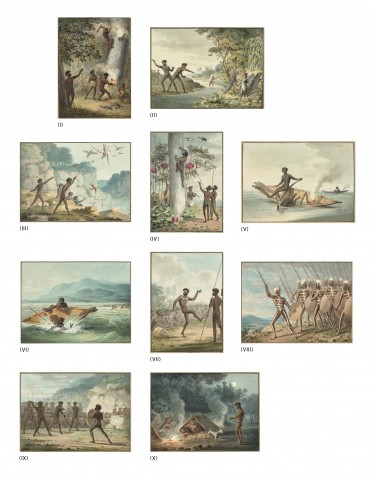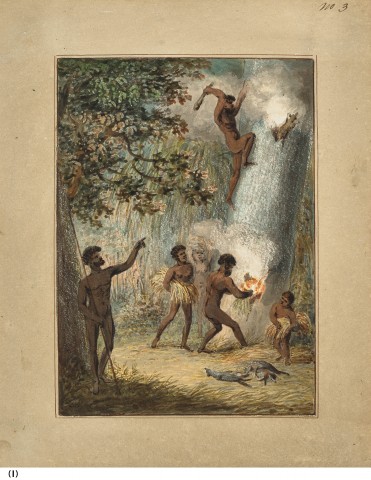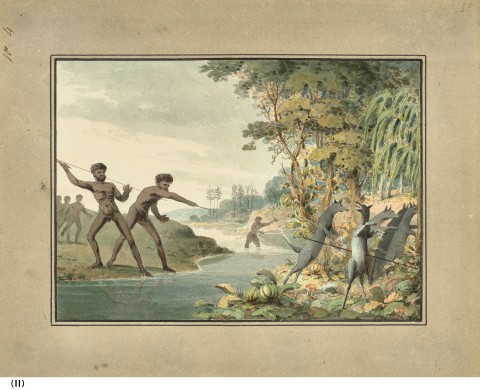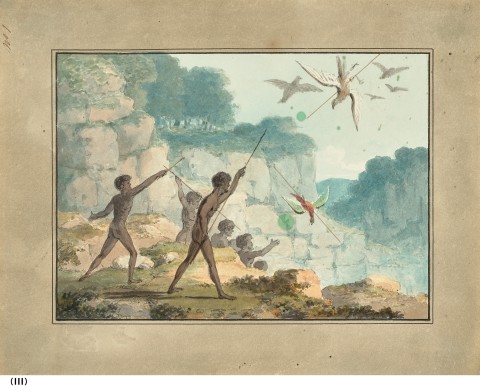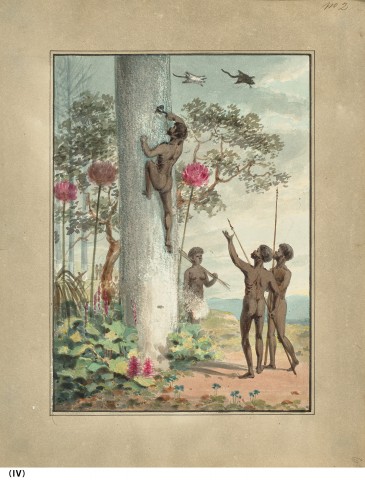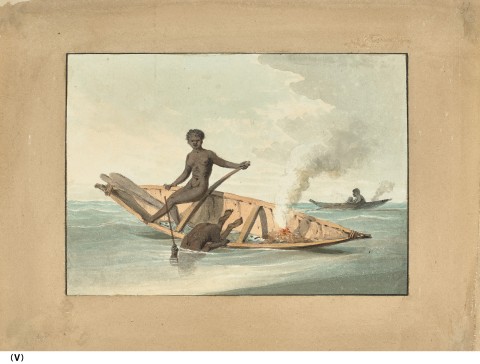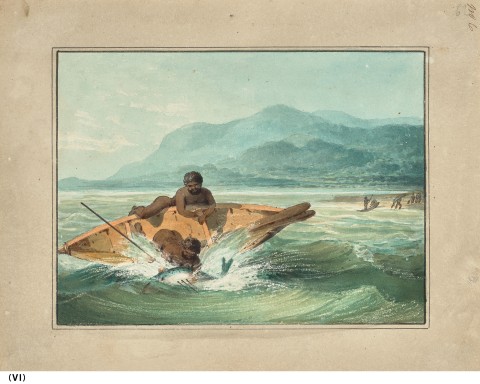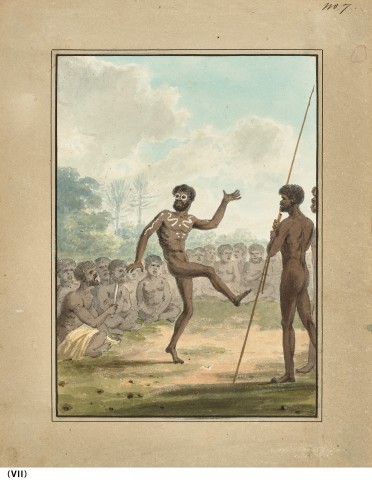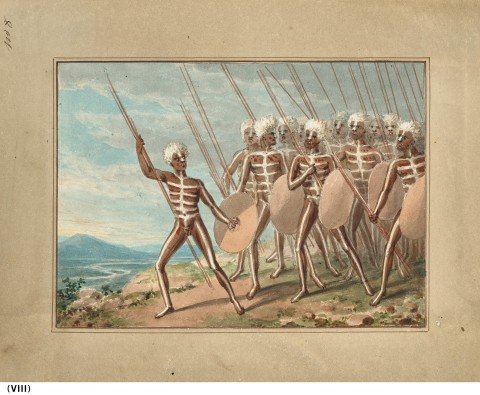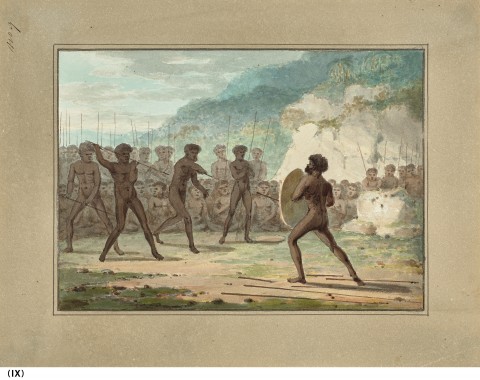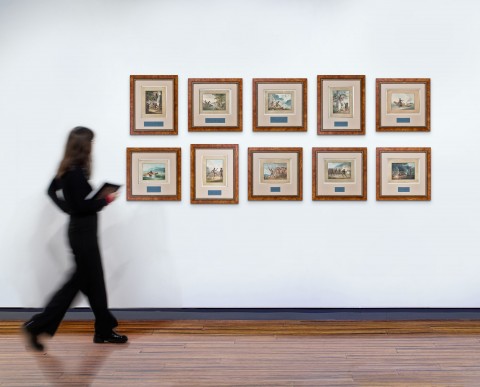FIELD SPORTS OF THE NATIVE INHABITANTS OF NEW SOUTH WALES, c.1813
JOHN HEAVISIDE CLARK
the complete series of ten images
watercolour over underdrawing in pencil
(i) SMOKING OUT THE OPOSSUM
18.7 x 13.5 cm (image)
inscribed upper right on margin: No 3
(ii) HUNTING THE KANGAROO
13.4 x 18.6 cm (image)
inscribed upper left on margin: No 4
inscribed upper right on margin: 58
(iii) THROWING THE SPEAR
13.3 x 18.7 cm (image)
inscribed upper left on margin: No 1
inscribed upper right on margin: 59
(iv) CLIMBING TREES
18.7 x 13.3 cm (image)
inscribed top right on margin: No 2
(v) FISHING NO. 1
13.3 x 18.7 cm (image)
inscribed upper right on margin: 61
(vi) FISHING NO. 2
13.4 x 18.2 cm (image)
inscribed upper right on margin: No 6 and 62
(vii) THE DANCE
18.8 x 13.2 cm (image)
inscribed upper right on margin: No 7
Watermarked: J WHATMAN1/ [possibly 1808? Partially legible]
(viii) WARRIORS OF NEW SOUTH WALES
13.3 x 18.6 cm (image)
inscribed upper left on margin: No 8
(ix) TRIAL
13.3 x 18.5 cm (image)
inscribed upper left on margin: No 9
(x) THE REPOSE
13.4 x 18.6 cm (image)
inscribed upper left on margin: No 10
Private collection
Sotheby's, London, 4 November 1987, lots 97 – 106
Dallhold Investments Collection, Perth
Sotheby's, Melbourne, 19 April 1993, lot 347
The Denis Joachim Collection, Melbourne
Thence by descent
Private collection, Melbourne
Australian Images: prints, drawings and watercolours from the collection, Art Gallery of New South Wales, Sydney, 22 December 1979 – 28 January 1980
Paradise Possessed: the Rex Nan Kivell Collection, National Library of Australia, Canberra, 6 August 1998 – 7 February 1999
Eora: mapping Aboriginal Sydney, State Library of New South Wales, Sydney, 5 June – 13 August 2006, cat. 16 (illus. in exhibition catalogue, p. 16, ‘Trial’)
John Heaviside Clark, Field Sports &c. &c. of the Native Inhabitants of New South Wales, Edward Orme, 1813 (illus.)
John Heaviside Clark, Foreign Field Sports, Fisheries, Sporting Anecdotes &c. &c., Edward Orme, 1814, [re–issue of 1813 [?]] edition as Supplement, pp. 157 – 170 (illus.)
Tableaux des chasses le plus intéressantes: représentées en gravures colonées, pouvant server d’études de lavis et d’aquarelle, chez A. Nepveu, Librarie, Paris, 1819 (illus. ‘Hunting the Kangaroo’, ‘Throwing the Spear’ and ‘Climbing Trees’)
Rienits, R. & T., Early Artists of Australia, Angus & Robertson, Sydney, 1963, pp. 196 – 97
de Teliga, J., Australian images: prints, drawings and watercolours from the collection, Art Gallery of New South Wales, Sydney, 1979
Bonyhady, T., Images in Opposition, Oxford University Press, Melbourne, 1985, p. 26
Wantrup, J., Australian Rare Books, Horden House, Sydney, 1987, pp. 280 – 283
Hoorn, J., The Lycett Album: drawings of Aborigines and Australian scenery, National Library of Australia, Canberra, 1990, pp. 3, 17, 25 (illus. ‘Throwing the Spear’ and ‘Trial’)
Shortbridge, S., (ed.), Paradise Possessed: the Rex Nan Kivell Collection, National Library of Australia, Canberra, 1998, p. 75
de Bussy, D., The Alan Bond Collection of Art, Dallhold Investments Ply Limited, 1990, pp. 22 – 29 (illus.)
Lawson, E., Birds! A National Library of Australia Exhibition, National Library of Australia, Canberra, 1999, pp. 4 (illus. ‘Throwing the Spear’), 9
Thompson, J. R., Collections in the National Library of Australia, National Library of Australia, Canberra, 2003, pp. 20 (illus. ‘Smoking Out of the Opossum’), 75
Renard, J., Aboriginal Life in Old Australia, Edition Renard, Melbourne, 2003 (illus.)
Grant, K., On Paper: Australian prints and drawings in the National Gallery of Victoria, National Gallery of Victoria, Melbourne, 2003, pp. 22 – 23 (illus. ‘The Dance’ and ‘Climbing Trees’)
Attenbrow, V., Sydney's Aboriginal Past: investigating the archaeological and historical records, University of New South Wales Press, Sydney, 2010 (illus. on front cover, ‘Smoking out the Opossum’)
230267 title page_cmyk.jpg
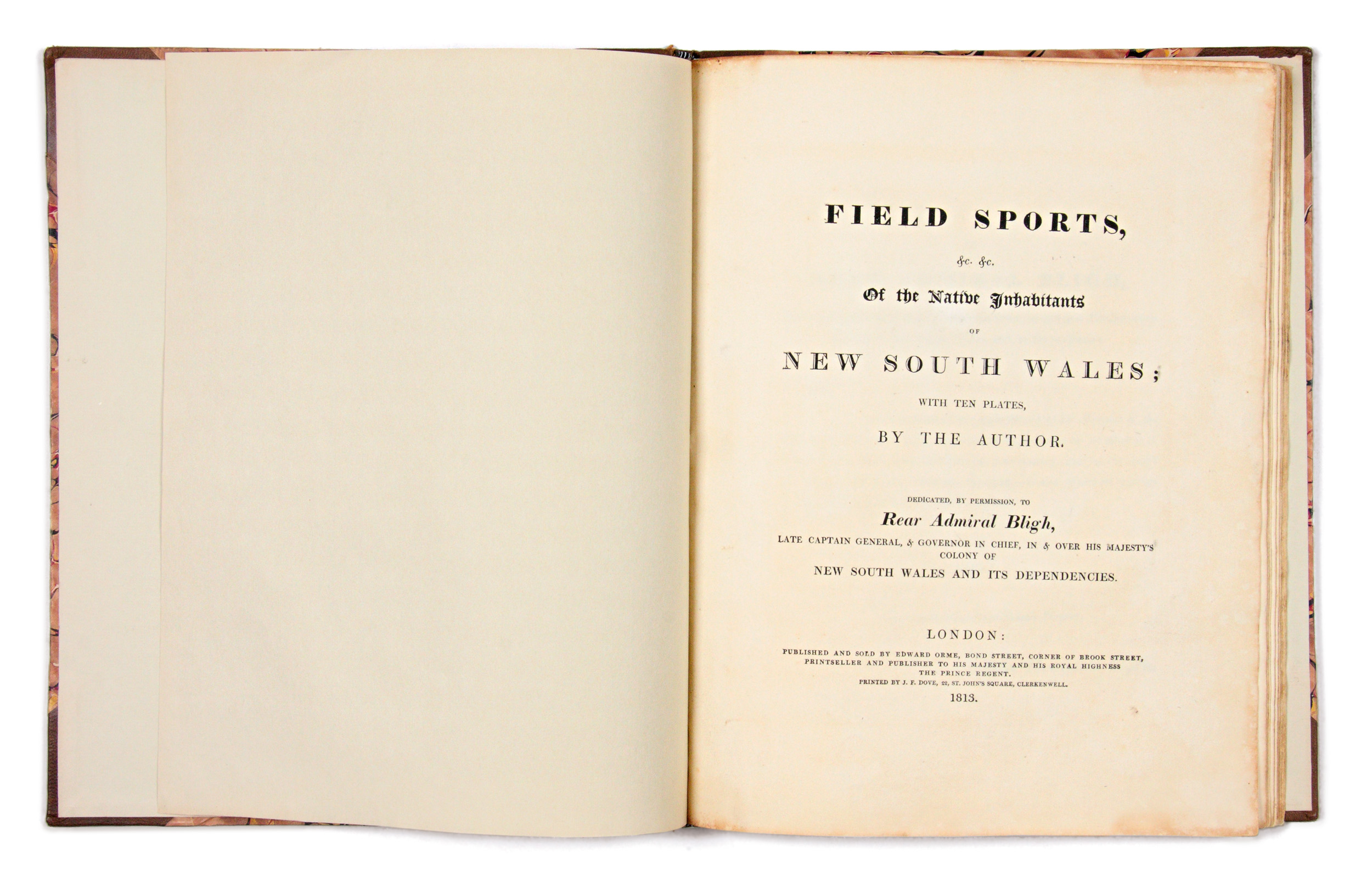
In 1813 a remarkable book of hand-coloured aquatints with accompanying text was produced in London. Titled Field Sports &c. &c. of the Native Inhabitants of New South Wales, it comprised ten scenes of Aboriginal Australians participating in a range of daily activities including hunting various animals, fishing and resting, as well as ceremonial scenes of dancing, ritual trial and preparation for battle. Published twenty-five years after the foundation of Sydney, it was the first book dedicated to this subject. These ten watercolours, in beautifully fresh condition, are integral to the production and promotion of this important volume, and thus to the European/settler visual representation of Australia’s First Peoples.
While unsigned, these paintings are undoubtedly by John Heaviside Clark (c.1771 – 1863), a prolific artist and printmaker active in London’s rapidly developing print trade, who produced numerous aquatint prints and illustrations for plate books, often collaborating, as in this case, with printmaker Matthew Dubourg and publisher Edward Orme. His subjects ranged widely – fox hunting, naval battles, Scottish landscapes, travel scenes, receiving the nickname ‘Waterloo Clark’ for his journalistic views following the Battle of Waterloo. He is almost certainly the J. Clark who aquatinted two panoramas of Warrane, Sydney Cove, based upon watercolours by the convict artist John Eyre. Published in 1810, these prints were then included in D.D. Mann’s A Present Picture of New South Wales (London, 1811).1
Field Sports of the Native Inhabitants was effusively dedicated to the most recently departed governor of New South Wales, William Bligh, who had been arrested and removed from office in the so-called Rum Rebellion:
To Rear Admiral Bligh, late Captain-General and Governor-in-Chief, in and over His Majesty's Colony of New South Wales, and its Dependencies. Sir, It is presumed this slight Sketch of the Manners of the Natives of New South Wales may assist in keeping alive the recollection of a distant spot, where your exertions for your country, and for the benefit of mankind, have been so eminently displayed. It also affords an opportunity for me to express my very sincere respect. I am, Sir, your much obliged humble Servant, John Heaviside Clark.
Dedications of this kind were common in books and on prints: a view of Sydney dedicated to John Hunter, printed following the end of his own earlier and also problematic governorship was similarly, albeit more subtly, worded.2 No connection between Bligh and Clark, or Orme, is yet known nor why such verbosity was warranted: Bligh was most unlikely to forget his unsuccessful term. However, given his reputation – Bligh had sailed with Cook on his last voyage, undergone mutinies both on sea and on land, and was a noted navigator – the dedication may have been chosen as a marketing ploy by Orme, selecting an individual most firmly connected in British minds with New South Wales at that time.
At the same time that Clark and Dubourg were creating the aquatints for the Field Sports of the Native Inhabitants, a substantial publication was also in production by Orme, which helps explain the unusual title. Foreign Field Sports, Fisheries, Sporting Anecdotes &c. from Drawings by Messrs Howitt, Atkinson, Clark, Manskirch includes one hundred action-packed aquatints with descriptive text, which depict (with varying degrees of accuracy) sporting and hunting activities from around the world. These range from Indian tiger and elephant hunting; Spanish bull-fighting; German bear- and wolf-trapping; Arabian hawking; Greenland sealing, and diverse techniques of killing and trapping from many other cultures. In this, Orme was cleverly appealing to the contemporary popularity of the British sporting print and the fascination with the unusual and unknown. Produced to the same scale and design, the ten Aboriginal scenes were included as a supplement (unnumbered plates 101 to 110) when the book was published in 1814.
The aquatints, and these watercolours, presented to a European audience the traditional owners of the distant British colony in striking compositions. However – unlike his visits to Belgium and Scotland – Clark never voyaged to New South Wales, nor are preparatory watercolours or drawings by others known. The mysterious source of such imagery has understandably been the subject of debate for many years, given the small British population in New South Wales in those years. Professional and amateur artists in the colony such as John Lewin, John Hunter and Philip Gidley King have been suggested. Watercolours attributed to King depicting Aboriginal people in a range of scenarios are suggestive.3 Yet in his known examples, the physical proportions and King’s observation of Aboriginal postures do not correspond with those we see here. Instead – and intriguingly – evidence indicates that these images derive from a combination of sources, united by Clark and drawn principally from previous publications about New South Wales.4
230267 the dance_cmyk.jpg
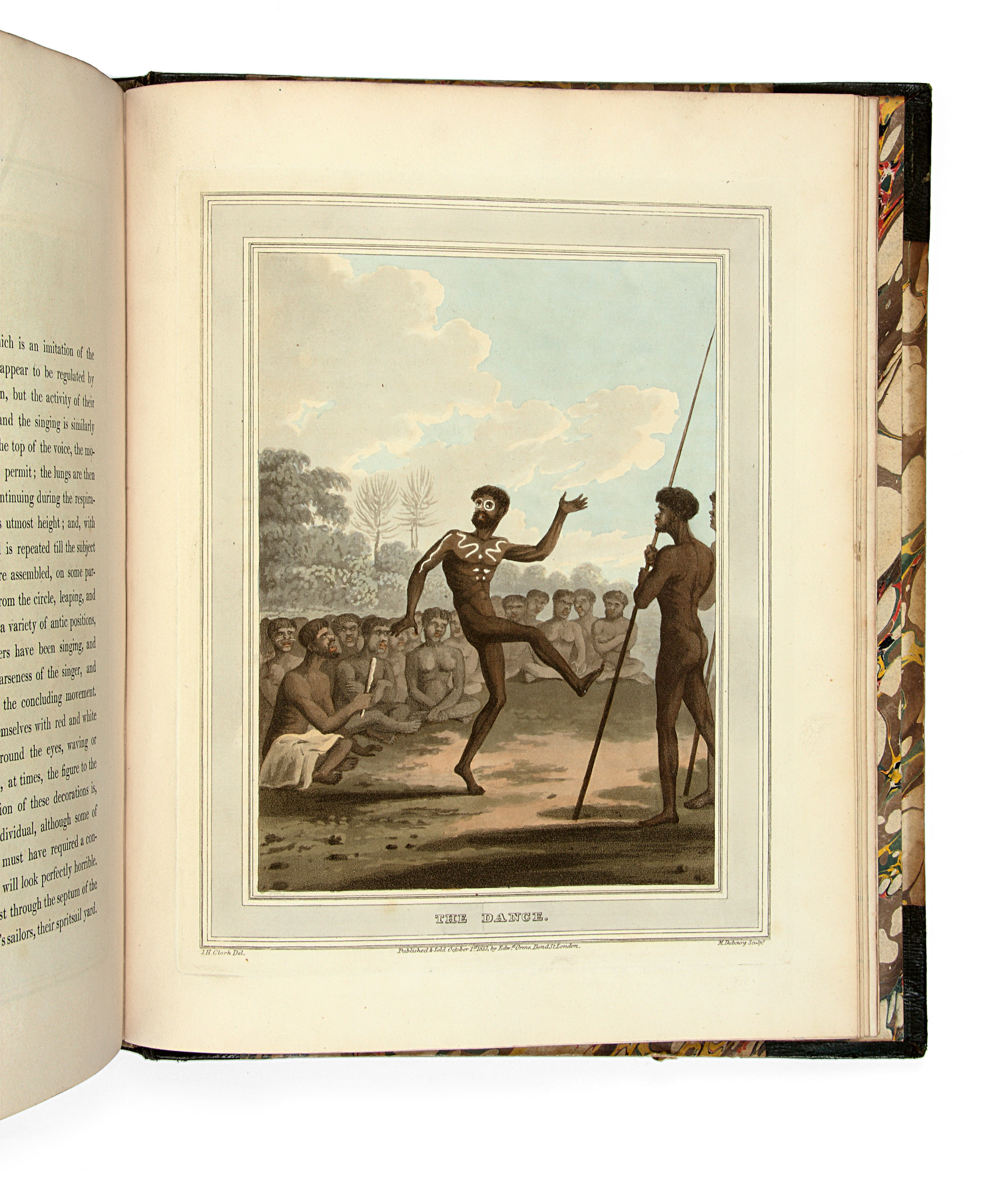
British accounts of the establishment of Sydney, the new environment and its inhabitants was a source of fascination for Europeans, with books, articles and images reprinted, translated, plagiarised and invented to meet demands for information and entertainment. Descriptions of interactions with and observations of Aboriginal people were frequent, most particularly in the substantial appendix (pp. 543 – 616) in Lieutenant-Colonel David Collins’ 1798 An Account of the English Colony in New South Wales, which was widely quoted and copied. Many of his descriptions of Aboriginal activities correlate closely with the scenes painted by Clark, as in The dance and Repose:
[Men] ornament themselves with red and white clay … with a large white circle drawn round each eye. In general waved lines were marked down each arm, thigh, and leg; and in some the cheeks were daubed; and lines drawn over each rib, presented to the beholder a truly spectre-like figure.
The hut of the woodman is made of the bark of a single tree, bent in the middle, and placed on its two ends on the ground … Being themselves sensible of the danger they ran in the night, they eagerly besought us to give them puppies of our spaniel and terrier breeds; which we did; and not a family was without one or more of these little watch-dogs, which they considered as invaluable guardians during the night.
In his previously mentioned publication of 1811, Mann writes in praise of hunting skills:
They are amazingly expert at throwing the spear, and will launch it with unerring aim to a distance of thirty to sixty yards. I myself have seen a lad hurl his spear at a hawk-eagle (a bird which, with wings expanded, measures from seven to ten feet), flying in the air, with such velocity and correctness as to pierce his object, and bring the feathered victim to the earth.
This description is perfectly captured in Throwing the spear, yet the birds bear no similarity to Australian birds. Similarly the vegetation throughout the series is unrecognisable as native, yet that seen in Hunting the kangaroo tallies with Mann’s odd description of pines being scarce, but melons ‘large and plentiful’. A noticeable absence in these views is the distinctive grass tree (xanthorrhoea), which was regularly included in early art as a symbol of the Australian landscape.
If these images were creatively compiled by Clark from textual sources, many anomalous details are explained, such as the round shields of the warriors who are painted identically ‘like so many moving skeletons’, and kangaroos like greyhounds on their hind legs (despite being on display in London menageries since the 1790s).5 At the same time, each of the scenes is clearly recognisable, showing Indigenous methods of climbing trees or smoking out prey, and details such as the use of the woomera, to further propel the spear, are accurately depicted, just as described.6
We do, however, know of one body of images accessible in London, being a series of etchings of stages of the male initiation ceremony that Collins, and his convict artist Thomas Watling, were permitted to witness. These were included in Collins’s appendix and bear a similarity of facial profile that may have been a source of physique for Clark.7 It is likely that other scenes in Foreign Field Sports were similarly composed from a combination of descriptions of activities, such as trapping crocodiles on the Nile or swimming for turtles, as well as observed and illustrated events, such as the more accessible bullfighting in Spain. It is worth noting that Orme’s title emphasised the role of the London draughtsmen involved in the publication, rather than the involvement of first-hand witnesses abroad.
This series then provides a fascinating insight into the way that Europeans were interpreting and visualising information being received from the distant colony of New South Wales. How do you envisage a Gymea lily if told of a giant pink flower on a single stem towering overhead? How do Aboriginal people dance? Furthermore it presented British and other readers with a view of communities, their food sources and their Country untouched by invasion, with no sign of their drastically changed world: 1813 was the year that British first crossed the Blue Mountains. Women’s primary role in fishing and food gathering is also overlooked in the images, although their skill was praised in the accompanying text. The exotic appeal of the series is confirmed by a reissuing of the Foreign Field Sports in 1819 and again in the mid 1820s, with a number of plates copied for a children’s book published in Paris in 1830, thus having a continuing influence on European perceptions of Australia in the nineteenth century.8
230267 climbing trees_cmyk.jpg
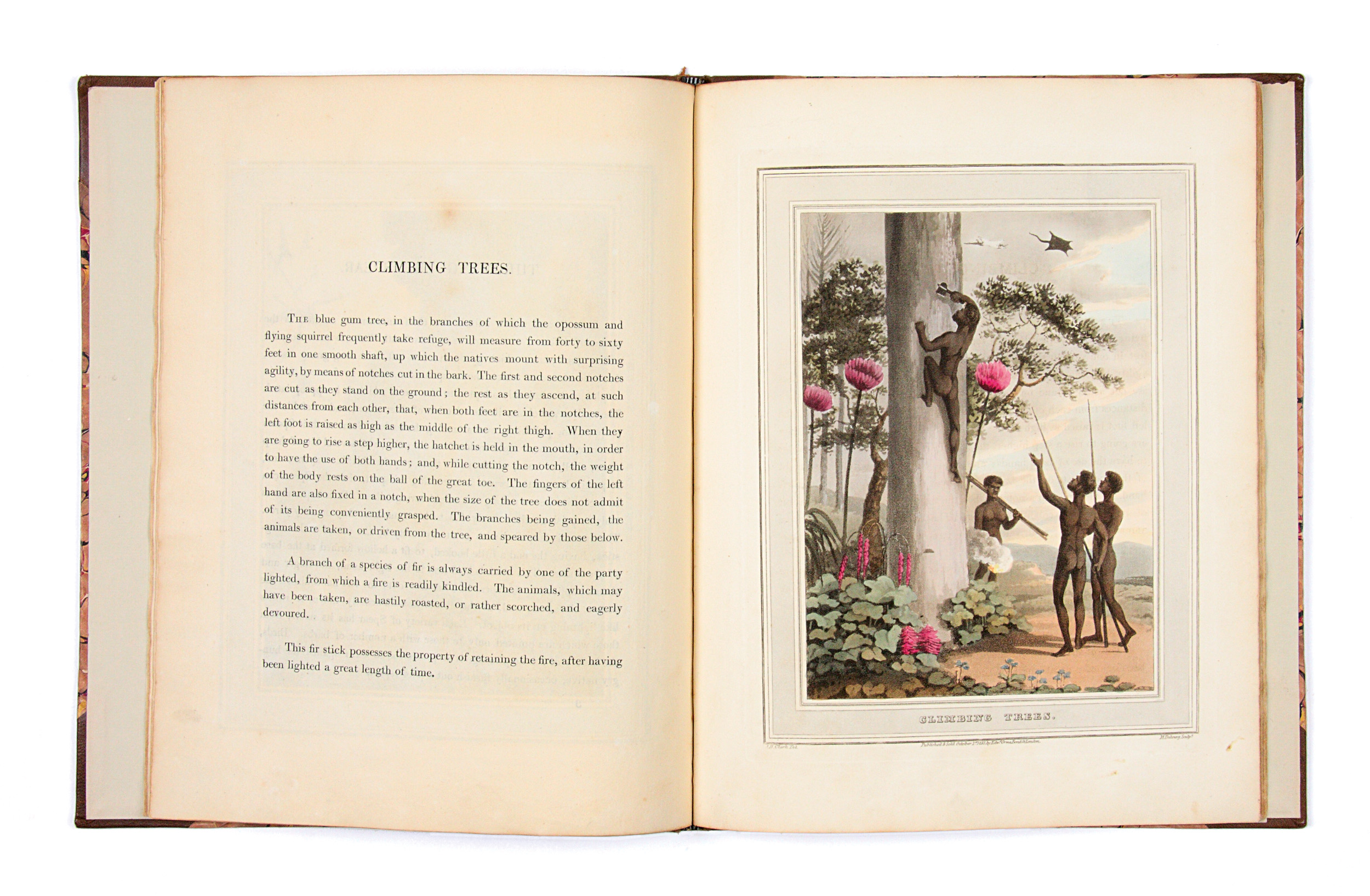
Most importantly these watercolours are captivating images, painted by a skilled artist who exhibited regularly at the Royal Academy throughout his long and productive career. Clark was also a teacher, author of A Practical Essay on the Art of Colouring and Painting Landscapes in Water Colours (1807) and A Practical Illustration of Gilpin's Day Representing the Various Effects on Landscape Scenery from Morning till Night, In Thirty Designs from Nature (1811), in which he demonstrated how to depict temporal and atmospheric effects. These glowing watercolours show Clark’s accomplished use of the medium, as in the energetic scratching back to capture the splashes of the speared fish in Fishing (No. 2). Slight differences, such as distant figures in Climbing trees or the spears in Warriors raise questions as to whether these were the source from which Dubourg etched the plates, or created as a unique set painted either for an individual or to promote the prints – either way, they are intrinsically connected with one of the earliest illustrated publications about Australia. That this set has remained in such superb condition and complete since 1813 is remarkable.
1. My thanks to Roger Butler for our discussions on this series. See Alexander, D., A Biographical Dictionary of British and Irish Engravers 1714–1820, Paul Mellon Centre, London, 2022, pp. 209 – 11
2. William Stadden Blake, after Thomas Watling, A view of the town of Sydney, 1802, etching and aquatint
3. See Hansen, D., ‘“Another man’s understanding”: Settler images of Aboriginal people’, in Leahy, C. and Ryan, J., (eds.), Colony: Australia 1770–1861/Frontier Wars, National Gallery of Victoria, Melbourne, 2018, p. 115 and n. 25.
4. As suggested by Renard, J., ‘Bibliographical and publishing notes’, in Aboriginal Life in Old Australia (Field Sports facsimile), Edition Renard, Melbourne, 2003, n.p.
5. Hunter, J., An Historical Journal of the Transactions at Port Jackson and Norfolk Island, John Stockdale, London, 1793, p. 57
6. See Urry, J., ’Savage sportsmen’ for discussion of early British perceptions of Aboriginal hunters, in Donaldson, I. and T., (eds), Seeing the First Australians, George Allen and Unwin, Sydney, 1985, pp. 51 - 67
7. However, this doesn’t explain Clark’s inaccurate depiction of round, rather than lozenge-shaped, shields. There would also have been access to A family of New South Wales, after Phillip Gidley King in Hunter, which depicts various cultural material.
8. Legrand, A., Album de la Jeunesse, Gide Fils, Paris, 1830
ALISA BUNBURY
